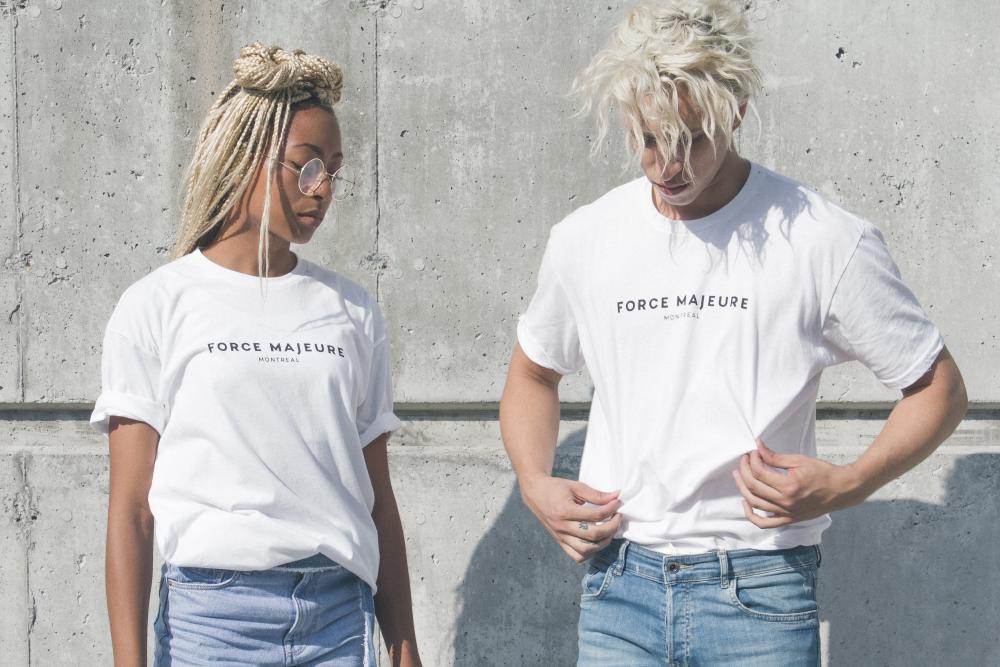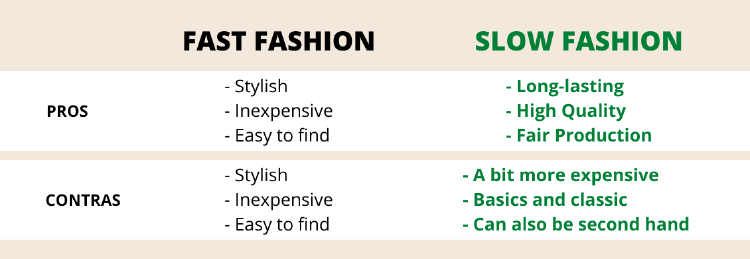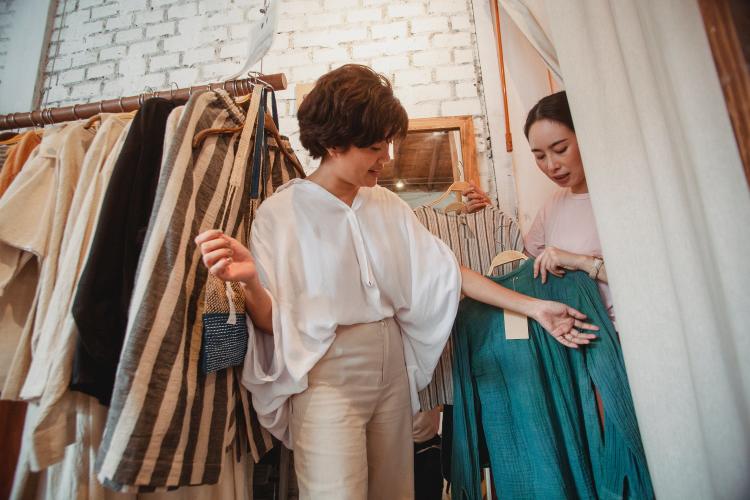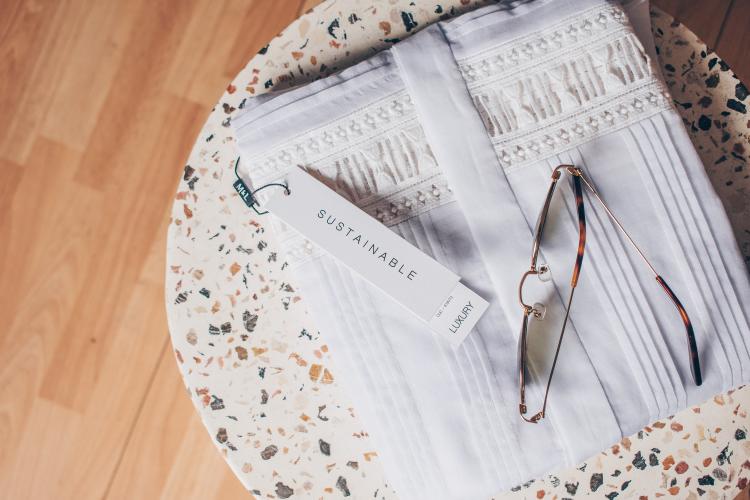
Slow food, slow life... rings a bell? Now, there is another term which is also part of this sustainable movement: slow fashion. As it sounds, the slow fashion vs fast fashion opposition highlights the need to slow down and think about production and consumption in the fashion industry.
Whereas fast fashion aims at producing large amounts of clothing and new collections every season, slow fashion brands advocate for small-batch collections, sustainable materials and long lasting garments. Slow fashion vs fast fashion is not only about materials and garments but also about the people behind all the making. Read more about fast fashion and its environmental impact on Fast Fashion: Why Should Be The Start Of Fashion Change?

Fast fashion is harmful for the planet but it’s cheap. Retailers in the fast fashion industry aim at producing more, at a fast pace and at the cheapest cost. So, it’s really easy for people to buy a t-shirt and then throw it away when trends change. All the clothes that are not sold end up in landfills, and that comprises 80% of the total production.
Needless to say the labor conditions under which many workers produce our fast-fashion clothing. Simply put, fast fashion is wreaking havoc on the environment. The slow fashion vs fast fashion battle is really necessary to raise awareness.
The idea of slow fashion was first introduced by design activist and professor Kate Fletcher. As she puts it, slow fashion brands encourage quality-based rather than time-based clothing. Choosing sustainable materials to produce clothes, buying less and choosing well-made lasting garments are the core principles of slow fashion.
From buying second-hand to buying better quality products, slow fashion vs fast fashion makes us think there are several ways you can turn to an ethical and compromised approach to fashion.
Slow fashion vs fast fashion: how do we make the transition? Changing purchasing habits that aim at buying less and better. Better choices include buying well-made garments with a longer lifespan, wearing your clothes as much as you can, mending worn items, donating, upcycling and redesigning your own clothes. Wearing clothing 50 times instead of 5 times (the fast fashion average) reduces carbon emissions by more than 400% per item per year. Amazing.
Some brands have already started in the slow fashion movement and are producing smaller batches, crafting each item with skilled artisans who are well paid and committing to slow-fashion solutions.
Choosing sustainable slow fashion brands, buying less and having a slow fashion mindset when purchasing are all decisions that make a difference in the slow fashion vs fast fashion dilemma.

This is an interesting brand that particularly publishes wages paid to all workers in the company. Makers from all over the world are included to produce the garments. The brand offers denim, jewelry, shoes and apparel. They make sure they source materials (mainly denim) via the western hemisphere to reduce our carbon footprint in shipping. The sweater collection is made of 100% organic cotton.
The brand offers XS to XL sizes. Mailers are recycled and they repurpose shipping boxes for storage.Cool, comfy and sustainable clothing.
This plant-based brand offers different garments for women, using low-impact fibers like Tencel, banana viscose and hemp, dyed with low impact, non-toxic dyes which aren't blended with synthetics.The company also recycle and reuse fabric scraps. Totally green brand to choose if you want to start wearing slow fashion items. Sizes from 0 to 12. Slow fashion solutions: eco fabrics, sustainable packaging.
Led by sustainable designer Eileen Fisher, the company produces minimalist items made of organic linen, hemp, and regenerative wool. The firm designs versatile shapes from the highest quality, most sustainable materials available. Used items are resold under their Renew take-back program in perfect conditions, so these items never end up in a landfill. Worn-and-torn pieces are redesigned to become pillows, curtains and other accessories. Slow fashion vs fast fashion also implies recycling clothes. Sizes range from XS – 3XL + petite sizes.
When talking about Fast fashion vs Slow fashion we think about quality products among other things. Tradlands offers timeless craftsmanship quality items through small-batch and responsible manufacturing.An interesting initiative is their Cost Per Wear principle. This equation means that items which are initially more expensive (compared to fast fashion clothes) turn out to be cheaper as you wear them over time. So, ultimately, you are buying now to prevent future spending and future waste. Totally sustainable.

Comfortable and elegant garments made from 100% organic cotton. Supportive of local craftspeople and artisans as well as women-and-minority-owned businesses in NY, this slow fashion brand company produces small-batch clothing to minimize the impact of their supply chain thus becoming a good example of what a slow fashion vs fast fashion brand is. What’s more, they require their sources to have a GOTS (Global Organic Textile Standard) certification to make sure they comply with standards of sustainability and labor rights. So, this company shows transparency and commitment in many aspects, delivering timeless designs that never go out of style.
TDO's main focus is on handmade garments. They highlight this feature as opposed to factory-produced items. Handmade clothing means designed and manufactured by one person from start to finish contrary to fast fashion items, sewn in batches and then assembled, going through different workshops. A good slow fashion vs fast fashion example.
One interesting and, actually, “green strategy” of the brand is their made-to-order production, that means clothes are made after you place an order. Think about it, made just for you! The lead time for made-to-order garments is at least 4 weeks, but you’ll finally get a limited edition high quality design, that’s for sure.
This is really great as they avoid overproduction and ultimately dispose of garments, thus helping create a mindful consumption trend among their customers.Deadstock fabrics are sourced in L.A, California and linen textiles, particularly, from suppliers in North America. Dead stock fabric is fabric that has already been manufactured but was unused, so they use a limited amount of each fabric creating unique pieces each time.
TDO garments are made of natural fiber textiles like linen, cotton, wool and hemp with minimal impact on the environment. Packaging is sustainable as well, 100% recyclable, biodegradable and reusable. TDO is an iconic slow-fashion brand you should consider.
Affordable, easy to wear sustainable loungewear. Made Trade’s core concepts and values are: heritage, fair trade, people-of-color and women-owned company, sustainability and vegan products.
Made Trade uses eco-friendly practices in the manufacturing process of their items using locally sourced materials. They advocates for fair wages for every artisan working in the industry.
The company claims to only curate vegan products from brands that use natural earth-friendly materials that are responsibly sourced, avoiding synthetic faux leather materials and choosing plant-based instead.Plus, garments are colored with AZO-free dyes .
Made Trade offers a variety of slow-fashion eco-friendly products. From apparel, jewelry, shoes and accessories to home and furniture.
Last but not least, they are a size-inclusive brand. Slow fashion vs fast fashion also includes thinking about a more inclusive planet.
When we talk about slow fashion vs fast fashion principles, clothing costs is the first thing that comes to mind: is slow fashion affordable? Is it worth it? What’s interesting about Everlane is their “radically transparent” principle. The brand shows you how much every item really costs to be produced. From materials to labor to transportation, you get to know everything. For sure, the items are produced to last, they use high quality organic materials to wear every piece for years to come. Soft cotton tees, cashmere sweaters, and Italian leather loafers, uniquely designed and manufactured. So, yes, it’s expensive, but it’s timeless.
The company even has a sustainable unisex sneaker line (Tread By Everlane) which claims to have zero carbon impact on its production. Bear in mind sneakers are not the most sustainable items in the fashion industry, using a lot of virgin carbon thus generating a great amount of carbon emissions. Everlane, though, uses leather. Again, not the greenest option. Anyway, they chose a clean and responsible supplier, Saigon TanTec, which is a certified Gold tannery by the Leather Working Group. TanTec uses less freshwater and less electricity compared to other companies in the industry.
Radical transparency, high-quality products and ethical factories. All you need to be part of the slow-fashion movement.

This original denim company restores your old Levi’s into creative designs, totally eco-friendly. Upcycling vintage into modern items. With Mexico and Turkey based factories, the company advocates for upcycling, recycling and circularity, turning that old pair of jeans into unique stylish pieces. They only partner with factories that take action to minimize the environmental impact of clothing manufacturing, which is a lot. Water used in production is also recycled to irrigate gardens in local communities, as well as pumice stones used in wash processes to create eco-bricks. RE/DONE creates vintage denim from scraps, literally. Perfect initiative for a greener fashion.
Well, this is one special slow fashion brand. Starting with their French name which means “green love”, this romantic clothing brand does everything to be among the favorites. The firm thought about every aspect of the industry: fibers and production processes used, labor conditions, how products reach every customer and how items can be recycled to avoid them ending up in a landfill. Any difference between slow fashion vs fast fashion?. Well...Their principle “Buy a Tee, We Plant a Tree” is sustainability at its best. They’ve planted over 350,843 in North America since they opened their doors.
Amour Vert uses sustainable harvested beechwood fibers, GOTS certified organic cotton, silk free of toxic substances, and eucalyptus trees to create their romantic items. They develop their own sustainable fabrics. Their signature fabrics include: Dream Collection, Washable Silk and Paris Rib. Lovely and dreamy garments you have to try, definitely.

Though you may think these brands are a bit expensive, think about the cost of a polluted environment. Honestly, supporting a more responsible fashion industry has a great environmental impact. You can recycle, mend torn clothes or donate garments you don’t wear anymore. Adopting a more minimalist style, turning to slow fashion purchasing habits will make you buy less and BETTER.
Fast fashion is killing our plants and animals and polluting the air we ALL breath. Taking action and adopting greener practices MEANS A LOT.
A complete guide about sustainable fashion can be found in Sustainable Fashion 101: All You Need to Know & A Complete Guide